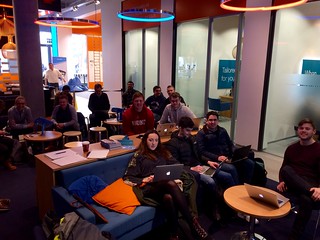 |
| https://www.flickr.com/photos/44739231@N05/sets/72157678760408683 |
We started much earlier than usual (8am) which, I'm sure most of the class were hoping, was a once-off. BoI are building a virtuous cycle of infrastructure, knowledge and community for incubating ideas to embryonic firms. The Workbench is one of a growing number of casual spaces that entrepreneurs can use for meetings, for hot-desking, to work and collaborate. The space is available on a first come first served basis. You get to use the WiFi, coffee/tea facilities, whiteboards and benches.
After the lecture, I was thinking back on that provocation in class, that we had missed the point of the reading (Vlaar et al, 2008). The point being that we too easily fall into the trap of seeing explanations and solutions to business problems in terms of the obvious things: needing tighter contracts, fixed milestones, more communication, better communication, shared understanding, making sense of situations etc. when in fact the obvious explanations are pretty hollow. Taking a closer look at the article we can see that some insights and better labels, better ways of talking about the challenge. We need their language to make these points and also to make the situation more meaningful. Three key concepts "sensegiving, sensedemanding, and sensebreaking" are a really novel way of approaching how to make the most of experience asymmetries. It is differences that end up creating new value even as they might also create problems.
"...understandings of requirements do not exist “out there” in the minds of stakeholders... they are dynamically constructed and negotiated during interaction processes" (Vlaar et al, 2008:pp239-8)So now, with this new rich language to describe (and manage) the interaction process we really can make it happen.
All the best
Allen
Reference:
Vlaar, P. W. L., Fenema, P. C. v., and Tiwari, V. (2008). Cocreating understanding and value in distributed work: how members of onsite and offshore vendor teams give, make, demand, and break sense. MIS Quarterly, 32(2):227–255.


